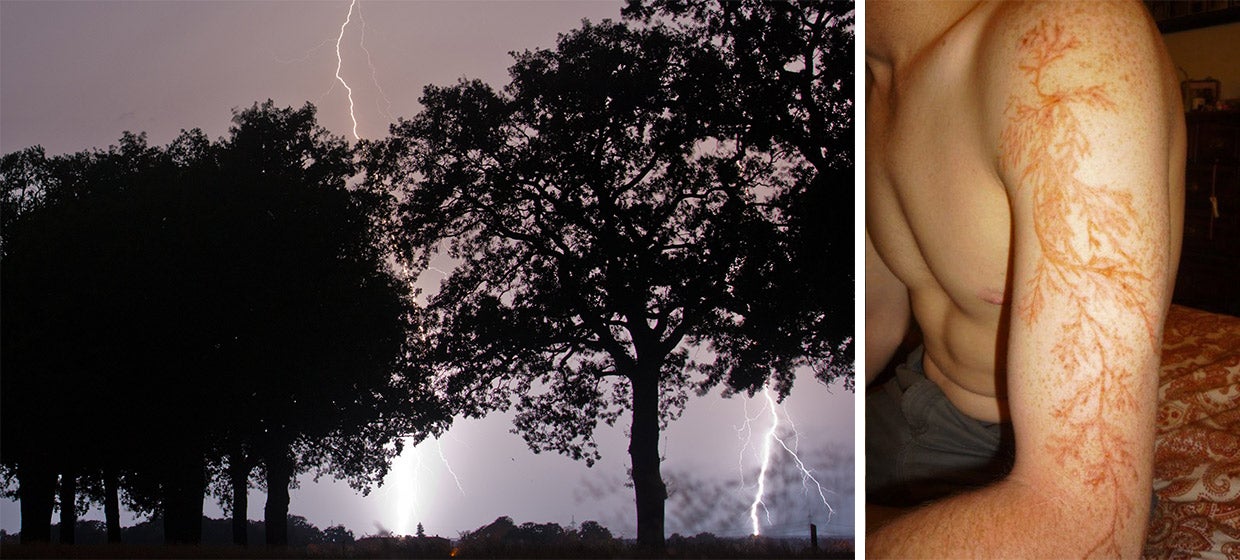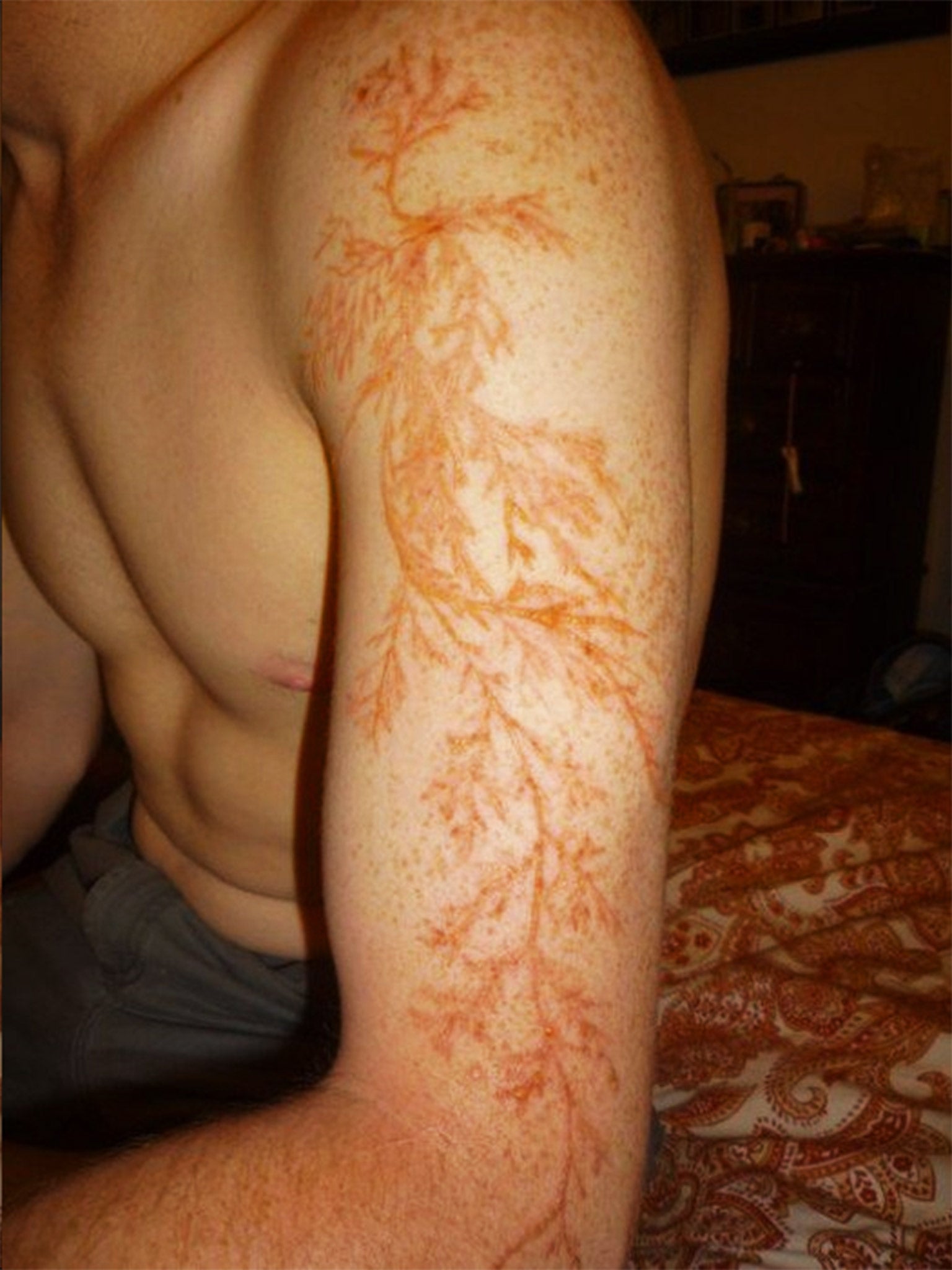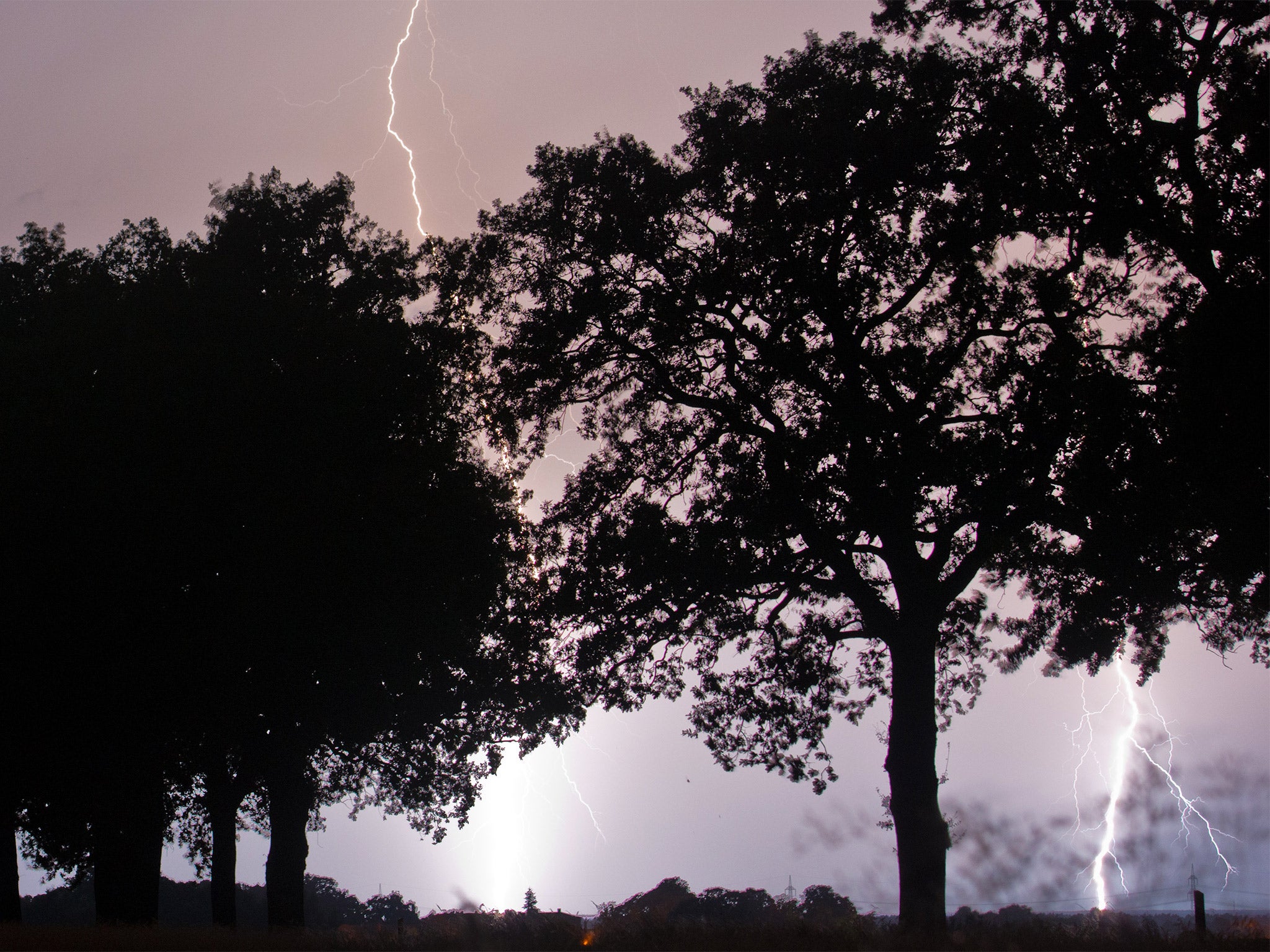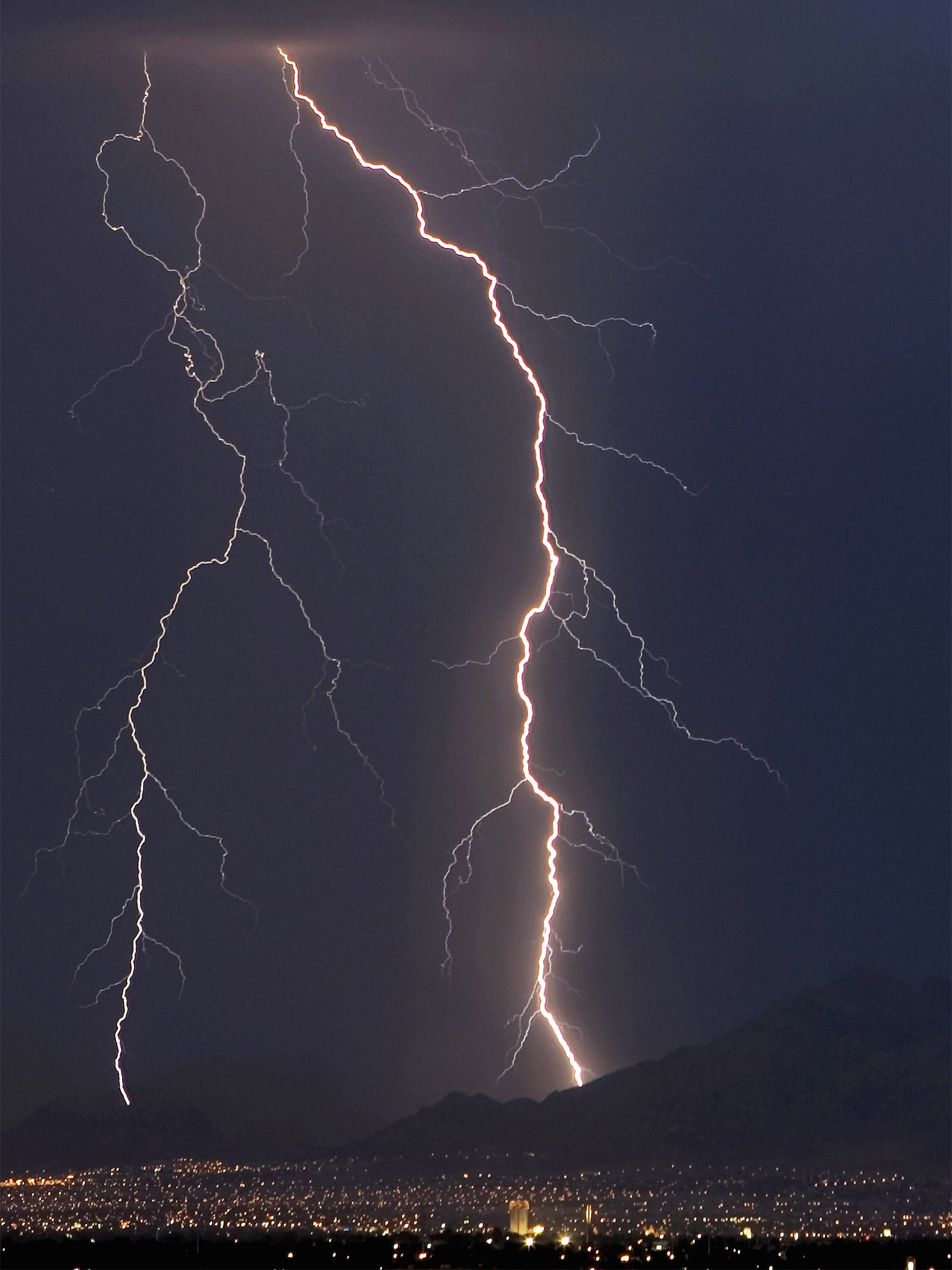What it's like to be struck by lightning (and survive)
Although 90 per cent of people hit by lightning survive, their minds and bodies are often changed in ways that are still unexplained by modern medicine

Your support helps us to tell the story
From reproductive rights to climate change to Big Tech, The Independent is on the ground when the story is developing. Whether it's investigating the financials of Elon Musk's pro-Trump PAC or producing our latest documentary, 'The A Word', which shines a light on the American women fighting for reproductive rights, we know how important it is to parse out the facts from the messaging.
At such a critical moment in US history, we need reporters on the ground. Your donation allows us to keep sending journalists to speak to both sides of the story.
The Independent is trusted by Americans across the entire political spectrum. And unlike many other quality news outlets, we choose not to lock Americans out of our reporting and analysis with paywalls. We believe quality journalism should be available to everyone, paid for by those who can afford it.
Your support makes all the difference.Michael Utley does not remember much about his death.
Over the years, he has woven together a narrative of what happened using threads collected from witnesses, friends and family. On 8 May, 2000, Utley, a 48-year-old stockbroker, was playing golf with his colleagues Dick Gill and Bill Todd, along with their friend Jim Sullivan, in the village of Pocasset, Massachusetts. Shortly after lunch, the dark clouds that had been mushrooming in the distance all morning were hovering close enough to merit the bleating of the course’s storm horn – time to clear the green. Gill, Todd, and Sullivan immediately headed towards the clubhouse. Utley walked back to the hole and returned the flagstick. Seconds later, the guys in front heard a thunderous crack and turned to see Utley stumbling to the ground, tendrils of smoke curling off his body. His shoes were several feet away from his body; his fingers looked like they had been flambéed; his eyebrows and wavy chestnut hair were wiry and crisped. Gill, an ex-Marine, ran to Utley’s side, began blowing air into his lungs, and instructed Todd to perform chest compressions. As Sullivan rushed off to get help, the clouds unleashed a deluge of rain and hail.
Utley cannot recall any of this. Not the arrival of the paramedics, nor having his heart restarted in the ambulance on the way to the hospital. His first memory after leaving the golf course is of waking up in a different ambulance, tubes down his throat, monitors everywhere, and a paramedic in a blue smock at his feet.
“Where am I?” Utley rasped.
“You’re on your way to rehab,” the paramedic said.
“What the f***happened?”
“You were struck by lightning 38 days ago.”
In popular culture, to be hit by a bolt of lightning is to suffer extremely bad luck. Rain, snow, and hail are largely indiscriminate: within a certain radius, everything is drenched, blanketed, or pelted. A cloud-to-ground lightning bolt is different. It blazes a discrete path through the sky. It appears to have choice. When lightning hits a human being, a survivor must reconcile not only what happened but why it happened. Why me? For most victims, it is not the unforgettable horror of an agonising ordeal that haunts them – many can’t even recall the incident itself; it’s the mysterious physical and psychological symptoms that emerge, often long after their immediate wounds have healed and doctors have cleared them to return to their normal routines. But nothing is normal any more. Something happened in a single moment – something strange and rare, something unbelievable – and after that moment, everything has changed.
Even more confounding is that almost no one in the mainstream medical community can explain what’s happening to them. Although many scientists have spent their careers examining the physics of lightning, only a handful of doctors and researchers study how lightning damages the human body. The incident rates are simply not high enough to warrant an entire sub-field of science. Nearly everything we know about treating lightning victims concerns the immediate wounds.

True entry and exit wounds are uncommon, but lightning typically leaves some kind of mark on the skin. One afternoon in 2009, a hiker named Becky Garriss awoke on the Appalachian Trail in Vermont, sitting on a bed of pine needles, her back against a tree, as though she’d fallen asleep in its shade. Her right arm was paralysed, pinned against her chest. Here and there, her trousers were charred. Although she was disorientated and scared, she managed to hike more than 10 muddy miles to call for help. When she got to a hospital, doctors recognised lightning’s smouldering touch on Garriss’s right arm and leg. A bolt probably hit her directly, they told her.
Other survivors awaken into temporary blindness or deafness; sometimes the concussive force of the strike – or the electricity itself – ruptures eardrums. Some victims report the taste of metal. Now and then, survivors develop strangely beautiful pink and brown bruises, which look like intricate henna tattoos of branching fronds. These bruises in all likelihood trace the path of electricity that forced blood cells out of capillaries into more superficial layers of skin.
In rare instances, the surge of electricity is enough to stop a victim’s heart and lungs. That’s what happened to Michael Utley. But cardiac arrest is something any paramedic knows how to handle. After leaving the hospital, Utley spent months relearning to swallow, move his fingers, and walk. Rehab was just the first chapter of his ordeal, however. In his previous life, Utley often went skiing and windsurfing. Today, at 62, he lives on disability insurance. “I can’t work,” he says. “My memory’s fried, and I don’t have energy like I used to. I aged 30 years in a second. I’m in pain most of the time. I can’t walk 100 yards without stopping. I look like a drunk.”
Lightning also dramatically altered his personality. “It made me a mean son of a bitch. I’m short-tempered. Nothing is fun any more. I am just not the same person my wife married,” says Utley, who is now divorced. Like many survivors, Utley sees his fateful union with lightning as more than just a close call he was lucky to survive. It marks a moment in which he was split from himself.
On a typical summer afternoon, thunder-clouds above the continental United States generate an average of 50,000 lightning flashes per hour. Two-thirds of these stay near the heavens. They pierce the sky with branching networks of blue and white fire, or strike out a short distance in thin tongues of electricity, or illuminate clouds from within. The remaining minority of lightning bolts, however, find earthbound targets – a church steeple, a telephone pole, a tree.

Rarer are bolts that directly strike humans. When people and lightning meet, however, death is an unlikely outcome. Roy Cleveland, a ranger at Shenandoah National Park, in Virginia, survived a record seven strikes between 1942 and 1977. This fact appears to defy logic. An average lightning bolt carries 500 megajoules of energy – enough to instantly boil 250 gallons of water. It heats the air it zips through to five times the surface temperature of the Sun. Still, around 90 per cent of lightning-strike victims survive. Over the past three decades, lightning has killed an average of 51 people per year in the US but left more than 500 injured and alive.
Lightning strikes are fundamentally different from the more common high-voltage electrical accidents in the home or workplace that people mistakenly compare them to. When an electrician inadvertently grabs a live wire, far less current typically seizes him than is contained in a lightning bolt, but it does so for longer. The surge of current causes victims to lose control, rendering them unable to let go. After a few seconds, the electricity coursing through the body has enough time to sear internal organs and interrupt the heart. Lightning strikes, lasting less than a half-millionth of a second, often scorch the skin but don’t cause internal burns.
Most of the electricity in a lightning bolt does not pass through the body. Rather, it dissipates over the skin in what’s known as a flashover. Vernon Cooray, a lightning scientist at Uppsala University in Sweden, explains the phenomenon by contrasting the ways a human body and a tree react when struck. Both trees and people are filled with a soup of water and minerals that conduct electricity pretty well. But because trees are covered in dry, inelastic bark, lightning travelling through the trunk has no escape route. It superheats the water and sap inside the tree into explosive steam, which can rip apart the trunk and branches.
A flashover can still do damage indirectly. The electricity crackling over the surface of the human body singes clothing, vaporises sweat and moisture into scalding steam, and renders metal objects such as belt buckles, keys and jewellery so hot that they burn the skin. Occasionally, all that steam blows victims’ shoes and socks off.
The best advice for people who find themselves outside during a lightning storm is simply to get inside, either a home or a vehicle. You’ll want to stay off the telephone, out of the shower, and away from sinks. Lightning can pass through landlines, plumbing and all manner of electrical wiring.
Mary Ann Cooper, Professor Emerita at the University of Illinois at Chicago, is one of the few medical doctors who have attempted to investigate how lightning alters the brain’s circuitry. A no-nonsense, bespectacled woman with a short-cropped bob of silvering strawberry hair, her fascination with lightning dates to childhood. “My dad swore his kids were not going to hide from thunderstorms in the closet or under the beds,” Professor Cooper, now 65, recalls. “Whenever we had a thunderstorm we always watched them.”
After more than three decades of examining lightning victims, Cooper still can’t definitively say what causes the chronic symptoms experienced by survivors. But she has some ideas.
The evidence suggests that lightning injuries are, for the most part, injuries to the brain, the nervous system, and the muscles. Lightning can ravage or kill cells, but it can also leave a trail of much subtler damage. Cooper and other researchers have speculated that chronic issues are the result of lightning scrambling each individual survivor’s unique internal circuitry. She points out that even tiny amounts of electricity zipping through the body can permanently alter the behaviour of neurons and other cells, which, to function correctly, depend on carefully orchestrated changes in the number of charged particles on either side of their membranes.
Faced with a medical community largely unable to help them, survivors frequently turn to one another. The US is home to at least two conferences of lightning-strike survivors each year – one in Pigeon Forge, Tennessee, and the other in Lynchburg, Virginia. In November 2010, I spent a couple of days at the Lynchburg conference. Each morning, attendees who had been injured by lightning or other electrical accidents gathered. One by one, survivors shared their stories.

Antoinette Palmisano spoke of the day in 1991 when she was struck by lightning inside a home office in Syracuse, New York. Lightning surged through the house’s electrical wiring, leaped out of a panel of switches like a poltergeist, seized Palmisano’s body, and threw her 10 feet across the room. Today, Palmisano still suffers from acute fatigue and has trouble remembering simple information. She plasters her home with Post-it Notes and places timers in every room. The scribbled instructions and alarms remind her about appointments, errands, and daily tasks that most of us easily juggle in our heads.
Listening to other, far more curious accounts, it became clear that some lightning-strike survivors fabricate or exaggerate parts of their stories – whether intentionally or not. A few claimed to have suddenly developed bizarre powers after the strike.
To some survivors, these more outlandish claims only serve to reinforce the idea that their very real issues are suspect, too. “I have met people who say they have been struck three times and say they can see the future, play the piano, f*** all night long,” says Utley. “It’s all bull****.”
About a year into his recovery, Utley attended his first survivors’ conference in Tennessee. There, he met Dr Cooper, who asked him to help launch an official lightning-safety awareness week, which kicked off in 2001. Its maxim: “When thunder roars, go indoors!” The next year, Utley created struckbylightning.org – a website devoted to educating people about preventing lightning injury – and started speaking at schools and to boy scout troops, and doing guest spots on televised weather reports. He continues to make educational outreach a priority.
Despite the personality change and relentless pain – despite the hunger for an explanation that would make sense of it all – Utley no longer fixates on a “why” that probably doesn’t exist. “Yeah, I was pissed off at first – I was p***ed off at the whole world,” Utley says. “I woke up and I couldn’t walk, couldn’t swallow, couldn’t do anything. What happened, and why? Why did I get struck and not the three guys 15 feet away from me? There’s no rhyme or reason. You can ask questions all you want, but it’s like yelling at the ocean. It does not answer back.”
This is an abridged version of an article that first appeared in ‘Outside Magazine’; outsideonline.com
Join our commenting forum
Join thought-provoking conversations, follow other Independent readers and see their replies
Comments